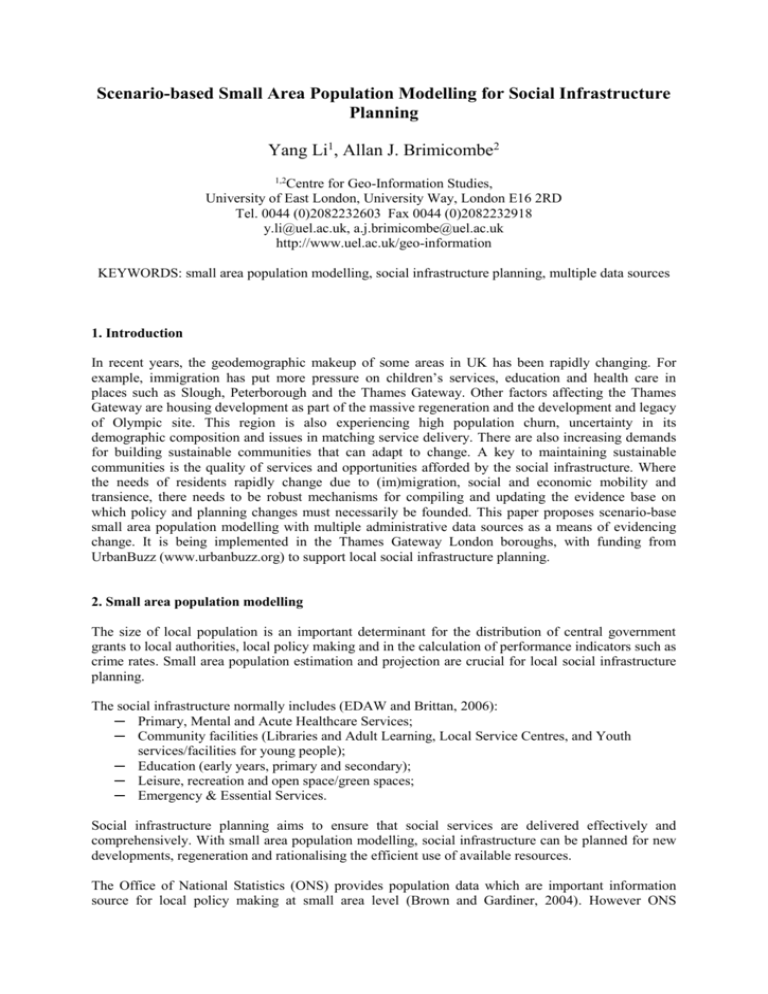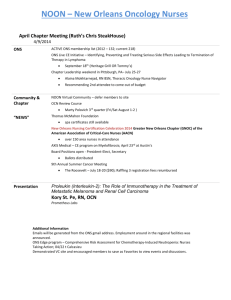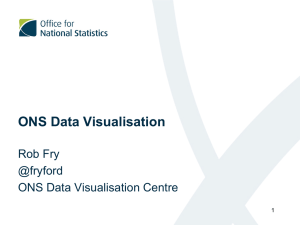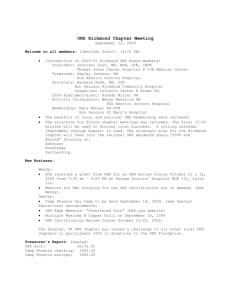Scenario-based Small Area Population Modelling Abstract
advertisement

Scenario-based Small Area Population Modelling for Social Infrastructure Planning Yang Li1, Allan J. Brimicombe2 1,2 Centre for Geo-Information Studies, University of East London, University Way, London E16 2RD Tel. 0044 (0)2082232603 Fax 0044 (0)2082232918 y.li@uel.ac.uk, a.j.brimicombe@uel.ac.uk http://www.uel.ac.uk/geo-information KEYWORDS: small area population modelling, social infrastructure planning, multiple data sources 1. Introduction In recent years, the geodemographic makeup of some areas in UK has been rapidly changing. For example, immigration has put more pressure on children’s services, education and health care in places such as Slough, Peterborough and the Thames Gateway. Other factors affecting the Thames Gateway are housing development as part of the massive regeneration and the development and legacy of Olympic site. This region is also experiencing high population churn, uncertainty in its demographic composition and issues in matching service delivery. There are also increasing demands for building sustainable communities that can adapt to change. A key to maintaining sustainable communities is the quality of services and opportunities afforded by the social infrastructure. Where the needs of residents rapidly change due to (im)migration, social and economic mobility and transience, there needs to be robust mechanisms for compiling and updating the evidence base on which policy and planning changes must necessarily be founded. This paper proposes scenario-base small area population modelling with multiple administrative data sources as a means of evidencing change. It is being implemented in the Thames Gateway London boroughs, with funding from UrbanBuzz (www.urbanbuzz.org) to support local social infrastructure planning. 2. Small area population modelling The size of local population is an important determinant for the distribution of central government grants to local authorities, local policy making and in the calculation of performance indicators such as crime rates. Small area population estimation and projection are crucial for local social infrastructure planning. The social infrastructure normally includes (EDAW and Brittan, 2006): ─ Primary, Mental and Acute Healthcare Services; ─ Community facilities (Libraries and Adult Learning, Local Service Centres, and Youth services/facilities for young people); ─ Education (early years, primary and secondary); ─ Leisure, recreation and open space/green spaces; ─ Emergency & Essential Services. Social infrastructure planning aims to ensure that social services are delivered effectively and comprehensively. With small area population modelling, social infrastructure can be planned for new developments, regeneration and rationalising the efficient use of available resources. The Office of National Statistics (ONS) provides population data which are important information source for local policy making at small area level (Brown and Gardiner, 2004). However ONS population data retain a degree of uncertainty and sometimes do not seem to match local events (ONS, 2003; Statistics Commission, 2003; Bates 2006). For some districts, the uncertainties in ONS population data could be raised by sampling errors, distribution of national adjustments, and undiscovered fieldwork failures (Simpson, 2007). In addition, ONS data often have a time lag between the data collection and distribution/publication. At the time of writing, the ONS have just released lower super output area (LSOA) mid-year population estimates (MYE) for 2005 and revised all estimates for previous years (but too late for inclusion in the analyses presented here). Scenario-based modelling has been widely used in population estimation and projection, although there are limitations for this approach (Booth, 2006). One single administrative data set may lack coverage, quality and content in order to be used directly (Bates, 2004). However, a broad range of administrative data sets and other data sources can be combined to overcome such weakness (Judson, 2007). The best way to integrate a range of administrative data sets is using small area geographies. Local administrative data sets tend to be more frequently updated. Multiple data sources can thus offer timely information for population modelling. Furthermore, with spatial analysis and statistical techniques, scenario-based population models can be constructed for small areas offer a basis for local social infrastructure planning (Alvarez and Mossay, 2006; Griffith and Wong, 2007; Oshungade, 1986). 3. Scenario-based population modelling for Thames Gateway London Boroughs The study aims to develop the geodemographic estimation/projection in supporting of social infrastructure planning for the Thames Gateway London Boroughs (Barking and Dagenham, Bexley, Hackney, Havering, Greenwich, Lewisham, Newham, Redbridge, Tower Hamlets, Waltham Forest). The geodemographic pattern in this area is complex and dynamic due to the inflow/outflow of (im)migration, changes in household composition and residential density, and the diversity of local communities. The ONS population data show uncertainty across the study area in estimation, projection and even in the 2001 Census figures. Figure 1 is the change between ONS 2001 and 2004 MYE which illustrates some stark contrasts between adjacent LSOA. Figure 2 shows the ONS imputation rate for the 2001 Census. Imputation rates are particularly high in the inner East London Boroughs. In Figure 3, the change of ONS MYE has been compared with the changes of dwelling stock counts and child benefit counts for the period 2001 and 2004. There are clear differences between ONS estimation and local scenarios. Figure 4 illustrates the change in the rate of school population growth from 2001 to 2006. There is a noticeably increase in the rates for the inner boroughs (except Hackney) after 2004 probably in response to immigration inflows after Eastern European countries joined the EU in 2004. In the proposed scenario-based small area population modelling, the basic geographic unit is LSOA and the baseline is between 2001 and 2007. The datasets are from multiple sources which include a wide range of administrative datasets and other relevant datasets including electricity and water demand data. The structure of proposed modelling is shown in Figure 5. In this structure, the raw datasets of local scenarios will be firstly cleaned and then checked with each other in order to control the data quality. After that, the raw datasets are aggregated or disaggregated to the same small area geography. Latent variables that reflect the underlying true population are subsequently inferred. Comparing these latent variables with ONS population estimates, the reference indicators are created for each LSOA to show the degree of difference between the ONS estimates and local trends evidenced in administrative data sets. Such reference indicators will inform local decision makers and planners in their use of the ONS estimates. The latent variables are further modelled statistically (e.g. regression) and are used in a projection model that incorporates neighbourhodd spatial dependencies. The scenario-based small area population estimation and their projection can thus be achieved. Figure1. Population change of ONS MYE (2001-2004) for Thames Gateway London Boroughs (data and boundaries Crown copyright) Figure2. 2001 Census imputation rate for Thames Gateway London Boroughs (data and boundaries Crown copyright) (ONS Imputation Rate: 1 - Less than 5%, 2 - 5% and less than 10%, 3 - 10% and less than 20%, 4 - 20% and over.) (a) Difference between the changes of ONS MYE and dwelling counts by LSOA (2001-2004) (b) Difference between the changes of ONS MYE and child benefit counts (2001-2004) Figure3. Differences between ONS MYE and local scenarios (2001-2004) for Thames Gateway London Boroughs by Ward (data and boundaries Crown copyright) (Difference index: 1 – ONS population increasing / local scenario variable increasing, 2 - ONS population increasing / local scenario variable decreasing, 3 - ONS population decreasing / local scenario variable increasing, 4 - ONS population decreasing / local scenario variable decreasing.) Percentage Change of School Population against 2001 for Thames Gateway London Boroughs 7% 6% 5% 4% 3% 2% 1% 0% -1% -2% -3% (Redbridge) 2001 2002 2003 2004 Individual Borough 2005 All Boroughs 2006 (Havering) Figure 4. Percentage change of school population for Thames Gateway London Boroughs (data Crown copyright) Scenario-based Population Projection Scenario-based Reference Indicators Scenario-based Population Estimation Neighbourhood Modelling ONS Estimates Statistical Modelling Inferred Latent Variables Raw Dataset1 Raw Dataset2 Raw Dataset3 …… Raw DatasetN Figure 5. The structure of scenario-based small area population modelling 4. Conclusion Population estimation and projections are crucial for local social infrastructure planning in support of sustainable communities. However, the ONS data exhibit a degree of uncertainty and sometimes do not match the locally evidenced events. The proposed scenario-based small area population modelling aims to offer an effective solution. The proposed modelling uses multiple data sources which include a wide range of administrative data sets and other relevant data sets whilst the spatial statistical techniques are applied through the modelling. 5. Acknowledgements The authors would like to acknowledge HEFCE and the DTI's Office of Science and Innovation funding of this study through the UrbanBuzz programme. References Alvarez J and Mossay P (2006) Estimation of a continuous spatio-temporal population model Journal of Geographical Systems 8 pp307-316 Bates A (2004) Small area population estimates project: data quality of administrative datasets Population Trends 116 pp11-17 Bates A (2006) Methodology Used for producing ONS's Small Area Population Estimates Population Trends 125 pp30-36 Booth H (2006) Demographic forecasting: 1980 to 2005 in review International Journal of Forecasting 22 pp547-581 Brown M and Gardiner C (2004) Information policy-making at sub-local authority spatial levels: Using small area micro-data from the 2001 census Local Government Studies 30(1) pp74-87 EDAW and Brittan B (2006) London Borough Barking & Dagenham Social Infrastructure Needs Assessment, Final Report. Griffith DA and Wong DW (2007) Modeling population density across major US cities: a polycentric spatial regression approach Journal of Geographical Systems 9 pp53-75 Judson DH (2007) Information integration for constructing social statistics: history, theory and ideas towards a research programme Journal of Royal Statistical Society A 170(Part2) pp483-501 ONS (2003). Census 2001 review and Evaluation: Edit and imputation report. Census Customer Service, Office for National Statistics, Titchfield, Fareham, Hants. http://www.statistics.gov.uk/census2001/pdfs/editimputevr.pdf Oshungade IO (1986) Use of percentage change in small area statistics The Statistician 35 pp531-545 Simpson L (2007) Fixing the population: from census to population estimate Environment and Planning A 39 pp1045-1057 Statistics Commission (2003). The 2001 Census in Westminster: Interim Report. Statistics Commission, London. Biography Dr Yang Li is a Research Fellow in the Centre for Geo-Information Studies, University of East London, UK. His research interests are in Geodemographics, GIS and environmental simulation modelling, spatial data analysis, spatial data quality, agent-based modelling and location-based services. Professor Allan Brimicombe is the Head of the Centre for Geo-Information Studies, University of East London, UK. His research interests are in spatial data quality, GIS and environmental simulation modelling, spatial data analysis and location-based services. Professor Brimicombe is a Chartered Geographer.





